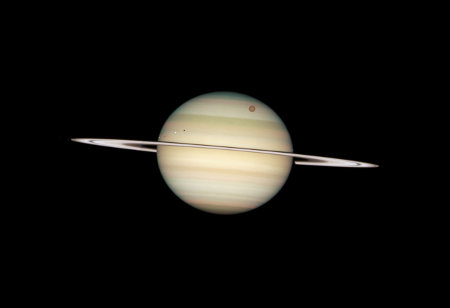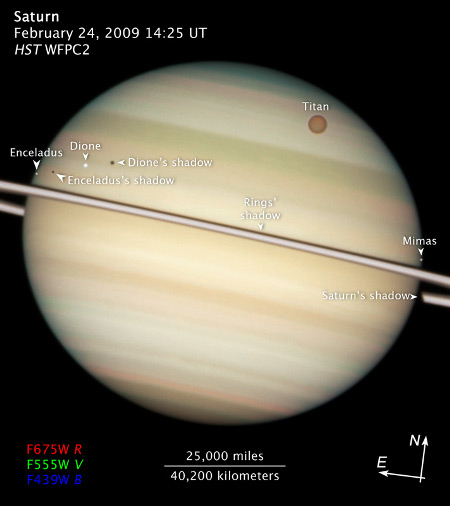Every now and then a new space photo completely snares the attention. This one is a Hubble shot showing four of Saturn’s moons moving in front of the planet. Note Titan at the top, while below it from left to right are Enceladus, Dione and (at extreme right) Mimas. To see the smaller moons, you’ll want to click the image, which will take you to a zoomable view that captures these tiny satellites against the immensity behind them.

Image: Saturn and four of its moons, as seen by Hubble’s Wide Field Planetary Camera 2 on February 24, 2009, when Saturn was at a distance of roughly 1.25 billion kilometers from Earth. Hubble can see details as small as 300 km across on Saturn. The dark band running across the face of the planet slightly above the rings is the shadow of the rings cast on the planet. Credit: NASA, ESA, and the Hubble Heritage Team (STScI/AURA).
The transit of the four moons is an unusual event because the rings only become tilted edge-on to Earth every fourteen to fifteen years (they’ll be completely edge-on on August 10 and September 4). The composite image below also shows the four transits, this time with labels, but again, be sure to click the image to get past our formatting limitations.
Image: A composite of separate exposures made by the WFPC2 instrument on the Hubble Space Telescope, showing all four transiting moons. Three filters were used to sample broad wavelength ranges. The color results from assigning different hues (colors) to each monochromatic image. Credit: NASA, ESA, and the Hubble Heritage Team (STScI/AURA). Acknowledgment: M. Wong (STScI/UC Berkeley) and C. Go (Philippines).
Early 2009 turns out to have been an excellent viewing season for those with small telescopes, who could watch moon and shadow transits across the face of Saturn. Titan has crossed the planet on four separate occasions since January. All of which takes me back to the little three-inch reflector I had as a boy, which I turned almost immediately to Saturn for a prized view of the rings. I can still recall the otherworldly feeling that came over me as, standing in my front yard in St. Louis, Missouri I suddenly brought Saturn into focus. It was small, almost minuscule, but the image burned bright as a jewel in that frosty Midwestern night.



Ya had me all confused at first. You mention Titan’s shadow in the top image. I’d click the top image to view it large (not the zoomable that you say), I’d note the location of the shadows of the other moons and their angle… Titan’s shouldn’t be there, but he says it’s “enormous” so I should be able to find it, but I sure don’t see it… I’d backup and re-read the first paragraph & check the image again… nope still don’t see it… Oddly I’d swear I saw Titan’s shadow in the image I saw on HubbleSite yesterday… So I went back and checked. I didn’t realize it was a whole sequence of images they posted. :) I think you posted the wrong image with the article.
One with Titan’s shadow and a link to the zoomable version is here:
http://hubblesite.org/newscenter/archive/releases/2009/12/image/a/
A six photo sequence here:
http://hubblesite.org/newscenter/archive/releases/2009/12/image/i/
And more here:
http://hubblesite.org/newscenter/archive/releases/2009/12/image/
Odd. The image is zoomable from here, and it’s the image I intended, which clearly shows Titan at the top. But no shadow — you’re right.
Later: I see why you were confused. In my editing I had changed the top image around and had forgotten the swap, which affected my text. Sorry! Text now fixed to reflect this. The image does zoom from here; hope it does elsewhere…
Image zooms for me.
Are there any pre-HST images of Saturn’s moons going across its
face during the other times its rings were edge-on to Earth?
I will even take drawings of the event, thanks.
http://antwrp.gsfc.nasa.gov/apod/ap090319.html
Saturn: Moons in Transit
Credit: NASA, ESA, Hubble Heritage Team (STScI/AURA)
Acknowledgment: M.H. Wong (STScI/UC Berkeley), C. Go (Philippines)
Explanation: Every 14 to 15 years, Saturn’s rings are tilted edge-on to our line of sight. As the bright, beautiful rings seem to grow narrower it becomes increasingly difficult to see them, even with large telescopes. But it does provide the opportunity to watch multiple transits of Saturn’s moons.
During a transit, a sunlit moon and its shadow glide across the cloudy face of the gas giant.
Recorded on February 24, this Hubble image is part of a sequence showing the transit of four of Saturn’s moons. From left to right are Enceladus and shadow, Dione and shadow, and Saturn’s largest moon Titan. Small moon Mimas is just touching Saturn’s disk near the ring plane at the far right.
The shadows of Titan and Mimas have both moved off the right side of the disk. Saturn itself has an equatorial diameter of about 120,000 kilometers.
i have 5″ mak. all last summer (2008) jupiter had many transits of it’s moons.
i saw many around dusk. this from jupiter watching for 30 years. well, i saw
30 years of transits in casually setting up my scope almost every evening!
Planetary Formation and Evolution Revealed with a Saturn Entry Probe: The Importance of Noble Gases
Authors: Jonathan J. Fortney, Kevin Zahnle, Isabelle Baraffe, Adam Burrows, Sarah E. Dodson-Robinson, Gilles Chabrier, Tristan Guillot, Ravit Helled, Franck Hersant, William B. Hubbard, Jack J. Lissauer, Mark S. Marley
(Submitted on 19 Nov 2009)
Abstract: The determination of Saturn’s atmospheric noble gas abundances are critical to understanding the formation and evolution of Saturn, and giant planets in general. These measurements can only be performed with an entry probe.
A Saturn probe will address whether enhancement in heavy noble gases, as was found in Jupiter, are a general feature of giant planets, and their ratios will be a powerful constraint on how they form. The helium abundance will show the extent to which helium has phase separated from hydrogen in the planet’s deep interior. Jupiter’s striking neon depletion may also be tied to its helium depletion, and must be confirmed or refuted in Saturn.
Together with Jupiter’s measured atmospheric helium abundance, a consistent evolutionary theory for both planets, including “helium rain” will be possible. We will then be able to calibrate the theory of the evolution of all giant planets, including exoplanets. In addition, high pressure H/He mixtures under giant planet conditions are an important area of condensed matter physics that are beyond the realm of experiment.
Comments: 7 pages. Submitted to the Giant Planets panel of the 2013-2022 Planetary Science Decadal Survey
Subjects: Earth and Planetary Astrophysics (astro-ph.EP)
Cite as: arXiv:0911.3699v1 [astro-ph.EP]
Submission history
From: Jonathan J. Fortney [view email]
[v1] Thu, 19 Nov 2009 03:53:57 GMT (701kb)
http://arxiv.org/abs/0911.3699
Saturn’s Exploration Beyond Cassini-Huygens
Authors: Tristan Guillot (CASSIOPEE), Sushil Atreya, Sébastien Charnoz (SAp), Michele K. Dougherty, Peter Read (AOPP)
(Submitted on 10 Dec 2009)
Abstract: For its beautiful rings, active atmosphere and mysterious magnetic field, Saturn is a fascinating planet. It also holds some of the keys to understanding the formation of our Solar System and the evolution of giant planets in general.
While the exploration by the Cassini-Huygens mission has led to great advances in our understanding of the planet and its moons, it has left us with puzzling questions: What is the bulk composition of the planet? Does it have a helium core? Is it enriched in noble gases like Jupiter? What powers and controls its gigantic storms? We have learned that we can measure an outer magnetic field that is filtered from its non-axisymmetric components, but what is Saturn’s inner magnetic field? What are the rings made of and when were they formed?
These questions are crucial in several ways: a detailed comparison of the compositions of Jupiter and Saturn is necessary to understand processes at work during the formation of these two planets and of the Solar System.
This calls for the continued exploration of the second largest planet in our Solar System, with a variety of means including remote observations and space missions. Measurements of gravity and magnetic fields very close to the planet’s cloud tops would be extremely valuable. Very high spatial resolution images of the rings would provide details on their structure and the material that form them.
Last but not least, one or several probes sent into the atmosphere of the planet would provide the critical measurements that would allow a detailed comparison with the same measurements at Jupiter. [abridged abstract]
Subjects: Earth and Planetary Astrophysics (astro-ph.EP)
Journal reference: Saturn from Cassini-Huygens, Dougherty, M.K.; Esposito, L.W.; Krimigis, S.M. (Ed.) (2009) 746-760
Cite as: arXiv:0912.2020v1 [astro-ph.EP]
Submission history
From: Tristan Guillot [view email] [via CCSD proxy]
[v1] Thu, 10 Dec 2009 15:28:11 GMT (490kb)
http://arxiv.org/abs/0912.2020